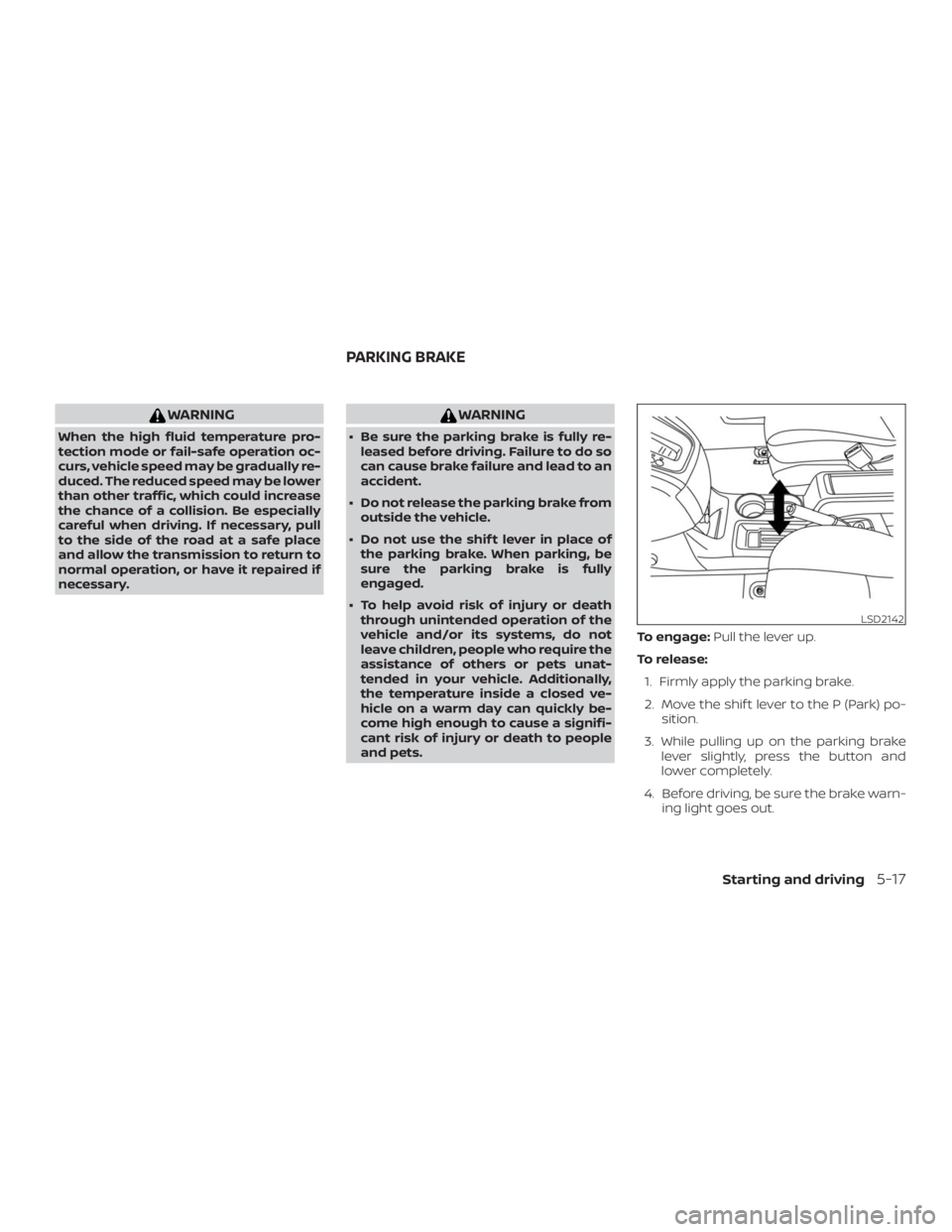Page 223 of 372
CAUTION
Do not place metalized film or any
metal parts (antenna, etc.) on the win-
dows. This may cause poor reception of
the signals from the tire pressure sen-
sors, and the TPMS will not function
properly.Some devices and transmitters may tem-
porarily interfere with the operation of the
TPMS and cause the low tire pressure
warning light to illuminate.
Some examples are:
∙ Facilities or electric devices using simi-
lar radio frequencies are near the ve-
hicle.
∙ If a transmitter set to similar frequen-
cies is being used in or near the vehicle.
∙ If a computer (or similar equipment) or
a DC/AC converter is being used in or
near the vehicle.
The low tire pressure warning light may
illuminate in the following cases:
∙ If the vehicle is equipped with a wheel
and tire without TPMS.
∙ If the TPMS has been replaced and the
ID has not been registered.
∙ If the wheel is not originally specified by
NISSAN.
Starting and driving5-5
Page 230 of 372
CAUTION
Running the engine with the engine oil
pressure warning light on could cause
serious damage to the engine almost
immediately. Such damage is not cov-
ered by warranty. Turn off the engine as
soon as it is safe to do so.
CONTINUOUSLY VARIABLE
TRANSMISSION (CVT)
CAUTION
To avoid possible damage to your ve-
hicle, when stopping the vehicle on an
uphill grade, do not hold the vehicle by
depressing the accelerator pedal. The
foot brake should be used for this
purpose.
The CVT in your vehicle is electronically
controlled to produce maximum power
and smooth operation.
The recommended operating procedures
for this transmission are shown on the fol-
lowing pages. Follow these procedures for
maximum vehicle performance and driv-
ing enjoyment.
NOTE:
Engine power may be automatically re-
duced to protect the CVT if the engine
speed increases quickly when driving on
slippery roads or while being tested on
some dynamometers.
5-12Starting and driving
Page 235 of 372

WARNING
� Be sure the parking brake is fully re-
leased before driving. Failure to do so
can cause brake failure and lead to an
accident.
� Do not release the parking brake from
outside the vehicle.
� Do not use the shif t lever in place of
the parking brake. When parking, be
sure the parking brake is fully
engaged.
� To help avoid risk of injury or death
through unintended operation of the
vehicle and/or its systems, do not
leave children, people who require the
assistance of others or pets unat-
tended in your vehicle. Additionally,
the temperature inside a closed ve-
hicle on a warm day can quickly be-
come high enough to cause a signifi-
cant risk of injury or death to people
and pets.To engage:Pull the lever up.
To release:
1. Firmly apply the parking brake.
2. Move the shif t lever to the P (Park) po-
sition.
3. While pulling up on the parking brake
lever slightly, press the button and
lower completely.
4. Before driving, be sure the brake warn-
ing light goes out.
LSD2142
PARKING BRAKE
Starting and driving5-17
Page 266 of 372

WARNING
� Do not continue to drive if your vehicle
overheats. Doing so could cause en-
gine damage or a vehicle fire.
� To avoid the danger of being scalded,
never remove the radiator or coolant
reservoir cap while the engine is still
hot. When the radiator or coolant res-
ervoir cap is removed, pressurized hot
water will spurt out, possibly causing
serious injury.
� Do not open the hood if steam is com-
ing out.
� Overheating can result in reduced en-
gine power and vehicle speed. The re-
duced speed may be lower than other
traffic, which could increase the
chance of a collision. Be especially
careful when driving. If the vehicle
cannot maintain a safe driving speed,
pull to the side of the road in a safe
area. Allow the engine to cool and re-
turn to normal operation.
If your vehicle is overheating (indicated by a
red high temperature warning light
),
or if you feel a lack of engine power, detect
abnormal noise, etc., take the following
steps.1. Move the vehicle safely off the road, ap-
ply the parking brake and move the
shif t lever to P (Park).
Do not stop the engine.
2. Turn off the air conditioner. Open all the
windows, move the heater or air condi-
tioner temperature control to maxi-
mum hot and fan control to high
speed.
3. Get out of the vehicle. Look and listen
for steam or coolant escaping from the
radiator before opening the hood. If
steam or coolant is escaping, turn off
the engine. Do not open the hood fur-
ther until no steam or coolant can be
seen.
4. Open the engine hood.
Page:
< prev 1-8 9-16 17-24